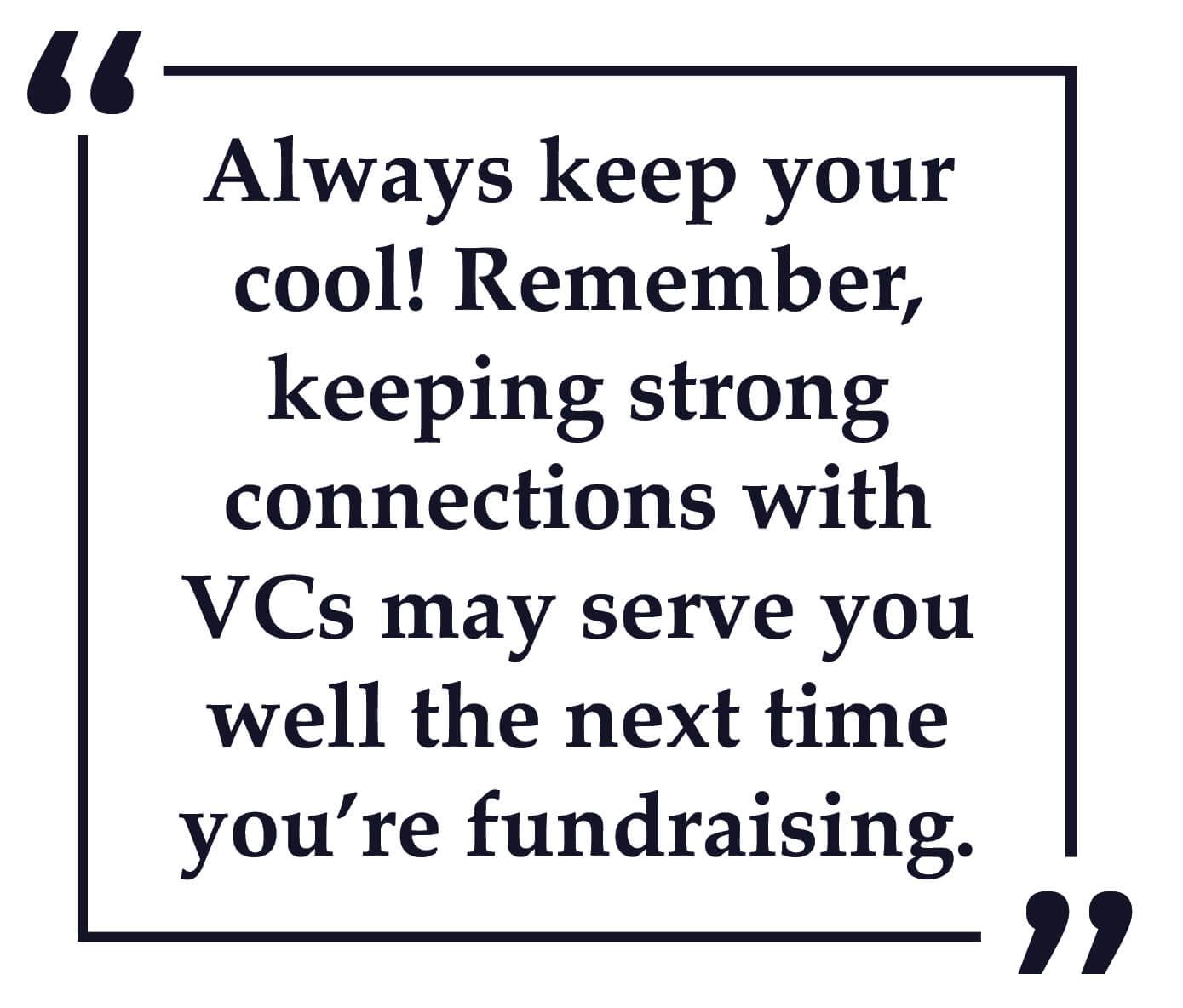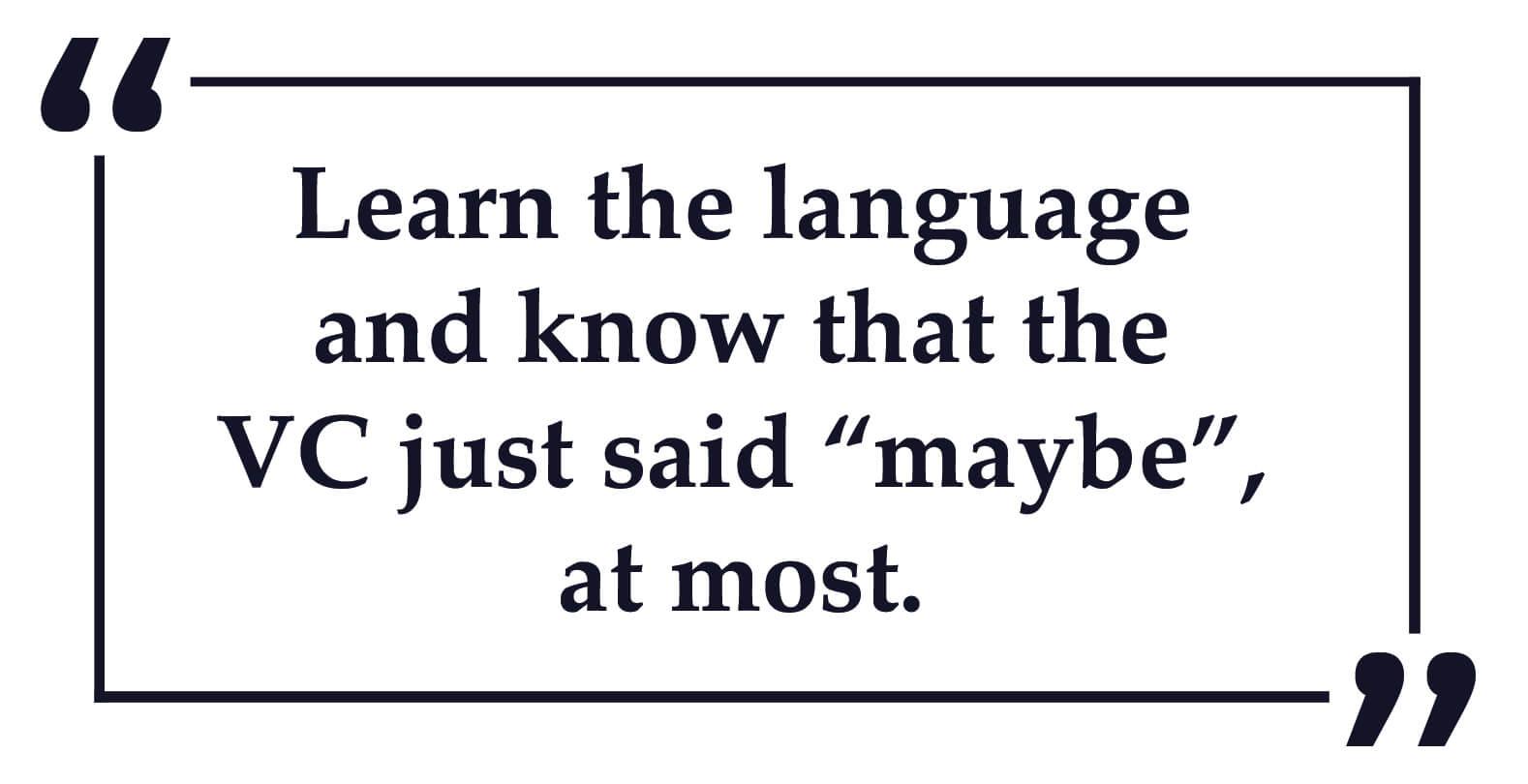

Top Founders know that fundraising is a critical skill that’s much harder than meets the eye. But what’s rarely discussed is this nuance in the Founder/VC dynamic:
Fundraising is a learned skill – and VCs almost always have the upper-hand because they deal with it all day, everyday.
Over the years founding, advising, and investing in companies, I learned that VCs are better at startup fundraising than entrepreneurs. In reality, knowing what to expect from VCs – the negotiation dynamics Founders are likely to encounter – is half the battle.
Before you start communicating with VCs, take the time to learn how to detect and manage these 8 little-known fundraising dynamics. This is what we at NFX call “high leverage fundraising” – it gives you speed & clarity, while still helping cultivate strong, long-term relationships. Let’s dig in.
Skill #1: Avoid The Portfolio Company Opinion
The VC Says:
A VC will sometimes ask Founders to meet with one of their portfolio companies in the same space/vertical so they can get their POV. This is usually a lose-lose situation. As a Founder, you don’t want to share your plans with a company so close to your space, and the portfolio company is likely to prefer that the VC not invest in another company in their space. 9 times out of 10 the existing Founders will tell the VC, “yes we are thinking of going into that business someday so please don’t invest in them.” Once the VC has that very conversation with the portfolio Founders, it’s VERY hard for the VC to override them and invest in you. The existing Founders have no incentive to let their VC invest. No upside, only downside. So the behavior is understandable, but a pain for you. And it’s part of the trap of a portfolio check. For VCs, this can be a heartfelt attempt to make a good decision or, in a bad scenario, an attempt to educate their portfolio company.
How to Reply:
If the portfolio company is too close to your business, explain to the VC that you are not comfortable discussing your company with them. For example: “I would be happy to meet anyone you want in general, but this company is just too close to our business to feel comfortable. Maybe there are other industry experts you would like us to meet instead?”
If the portfolio company isn’t a threat to your business, then meet the Founders and get a sense of what their experience has been like working with the investor–take advantage of the opportunity.
Skill #2: Be Careful Communicating Your Valuation
The VC Says:
VCs will often ask Founders to “name their price”. This is a fair question for the VC, who will not pay more than they think the company should be valued at in any case. But Founders who are afraid to look too aggressive will often name a low valuation, thinking this means less price negotiations. In reality, the low valuation becomes the starting point of the negotiation.
How to Reply:
The best way to approach this situation (unless, of course, the negotiation is an extension of an existing round or a note that already has a set price) is to politely say: “We don’t know yet. We will let the market set the price.” If you had a previous round, share any relevant information about that round at this point in the conversation. Include any notes that could help set the tone of the current round versus the previous one.
For example: “Our post-money valuation of the previous round was $8M and we made progress: our revenues grew by 80%. We will let the market set the price.”
Skill #3: Manage the Lowball Offer
The VC Says:
VCs often “lowball” Founders during startup fundraising. Sometimes it’s a sign of a bad VC but more often than not, it’s simply the starting point of a negotiation. Many inexperienced Founders don’t realize this, and they get flustered. This can lead to the deal going sour, and dying – even though it doesn’t have to.


How to Reply:
First, manage your emotions and don’t be insulted! This is a dance and you know the moves as well. Thank the VC for the offer, let them know you think the offer is low, and then simply slow down the process. You always want to keep the offer as a backup so you can truthfully tell other VCs that you are in discussions with others. When you see you have interest at reasonable price, get in touch with the lowballer VC, apologize, and say that another offer came in at a much higher price. The VC may then suddenly be open to a higher valuation.
For example: “Thanks for the offer. This is dramatically lower than what we had in mind but let us get back to you.”
Then, once you have interest: “Sorry it took us time to get back to you, but we were getting offers from other VCs at a much higher valuation range. We understand this may not be right for you–let us know if you want to discuss.”
Always keep your cool! Remember, keeping strong connections with VCs may serve you well the next time you’re fundraising.
Skill #4: Anticipate the Lowball Curveball Offer
The VC Says:
Knowing what to expect is half of the game. Sometimes, when a VC is friendly and supportive in the meeting, it leaves Founders feeling like they will get a strong valuation – even though no valuation was discussed. Later, if a lowball offer comes in, the Founder feels they were just handed a “lowball curveball”. Now in a very emotional state, Founders tend to accept a lowball curveball more often than a standard lowball, convincing themselves that if the valuation came from someone so friendly it must be the right one.
How to Reply:
Friendliness is often sincere, but it’s important not to confuse liking the VC with agreeing with their valuation. The key here is this: don’t get swept up in emotion. You are likely to overestimate how enthusiastic a VC really is about the deal, so don’t be surprised by a lowball curveball. Here use the same fix as you would for a lowball (#3 above) – only be even more cool!
For example: “Thanks for the offer. We also loved the meeting and felt we could work well together. But this valuation is just so low that it seems out of market. Let us think about it and get back to you. We would of course love finding a way to work together!”
You, too, can be extremely nice!
Skill #5: Talk in Pre-Money Valuation During Startup Fundraising
The VC Says:
VCs talk a lot in post-money valuation, but wise Founders learn (sometimes the hard way) that this can lead to a lower valuation. For example, a typical discussion may see a VC talking about investing $2M at an $8M post money valuation (so essentially $6M pre-money valuation). But if things go well and the Founders want to raise more in the round–say an additional $1M, for a total of $3M–the VC will often say, “we agreed to an $8M post-money valuation.” So at $3M, the round is suddenly a $5M pre-round, and the VCs get 37.5% (3/8) instead of 33 ⅓ (3/9). Unfortunately, the honest Founder who agreed to the post-money valuation has no option but to accept.
How to Reply:
The wise Founder move here is to shift the discussion back to pre-money valuation. For example: “Thanks for the offer, but to be clear, this means a $6M pre-money valuation. I am not sure what the eventual sum we raise will be, so it’s important that we agree on a pre-money valuation.”
Skill #6: Master the Math of ESOP Allocations
The VC Says:
Sometimes VCs will ask for an excessive ESOP allocation. It’s in a VC’s interest to have as much ESOP as possible allocated before the round because it means less future dilution for the VC. Remember, part of the job in VC is to de-risk investments as much as possible.
Furthermore, in an early exit scenario the unallocated ESOP benefits all shareholders–not just the Founders who are the ones diluted from the pre-round ESOP allocation. While every round has an ESOP allocation (or top-up in case of a later round), the numbers vary dramatically. And it isn’t unheard for a VC to ask for 20% ESOP, sometimes even more.
Also remember that to get to 10% ESOP post-round where the dilution is, say, 25%, you actually need 13 ⅓ % ESOP before the round as the ESOP is also diluted by the round.
How to Reply:
First, know the market standard. 10-15% available ESOP post-round is common for seed deals. 7.5-10% ESOP is common for A rounds.
Then show the ESOP requirements you’ll need until your next round – that’s the amount the VC should care about and push for. Keep in mind that the more complete your team is, the less ESOP you’ll need. Be clear about whether you are talking pre-round or post-round numbers. Again here, the VC is likely to talk in post-round numbers.
For example (seed deal): “We are 3 Founders who cover between us product, tech, and sales. We need a CMO and have already found the person. Getting him/her requires 2% ESOP. For the rest of the team our plan shows we’ll need an additional 5% ESOP for the coming 18 months, which brings us to 7% total. We therefore think that 10% ESOP post-round is enough.”
Skill #7: Know the Leaders from the Followers


The VC Says:
It is important to understand that when VCs meet a good team, they have no reason to stop the discussions, even if they can’t make up their mind on whether to invest. VCs almost always prefer to stay in the loop and keep their options open, rather than giving an outright “no”. It’s possible that a top fund could take the lead, and that could make the VC want to jump in. How do they do this? One way is that they “commit” but with certain contingencies, like the Founders having to “find the lead” or “bring the rest of the money first”. What a VC is actually communicating is, “I like what you’re doing, but not enough to lead.”
How to Reply:
Learn the language and know that the VC just said “maybe”, at most. Do your best to get the investors to commit to putting their money in without any contingencies. And give lower priority to those who “don’t lead”. (By the way, not leading is usually just an excuse – most VCs, aside from some later stage investors, lead a round when they are super excited about the deal.)
At the same time, you do not want to push the VC away. The message that you have follow-on investors lined up could be beneficial when you talk to your potential leads.
For example: “Thanks for believing in us! We are now indeed focused on finding our lead and will be in touch when we do. Hopefully once we find the lead we will still have room in the round.” Or in other words: if you want to secure your participation, you have to commit NOW.
Skill #8: Control the Deadline
The VC Says:
We at NFX don’t really like “exploding term sheets” that expire after just a few days. Simply put, healthy Founder-VC communication can overcome the need for such mechanisms. However, Founders sometimes drag the fundraising process beyond a reasonable period of time in hopes of getting more term sheets. As such, exploding term sheets and term sheet deadlines have become very common.
Normal deadlines are around one week, giving the Founders enough time to review their options and decide. But we’ve seen VCs (even good ones) give Founders much shorter deadlines, even as little as one day. This doesn’t let Founders appropriately evaluate their options and often leads to suboptimal deals. Adding insult to injury, short deadlines are often accompanied by a lowball offer.
How to Reply:
Remember that you are entering a very long-term relationship here, which is supposed to be with people you can trust and enjoy working with. Ask yourself whether you want a partner who is so aggressive at the first interaction. Next, ask for an extension. If the VC isn’t willing to give you a reasonable amount of time (at least a few days) to consider your situation, it’s ok to push back. Here’s the truth: if a VC really likes your business and your team, she/he is unlikely to not invest because of a day or two. Just as you are likely to be wrong about how excited an investor really is about your company, you are likely to misjudge how long it takes to close an investment and the investor’s real red lines.
In any case, there’s no need to disengage with the VC because of the unfair deadline. Play the game and get back to the VC in the final moments of the deadline to say that you need more time. Always have the option on your side. Another tactic is to delay the deadline by asking the investor for something that will take time.
For example: “Thanks for the term sheet, but we just don’t think we can sign it within 24 hours-we need to review our options and also consult with a few people. Also, before we proceed, can you please provide us with a few Founders you invested in that we can chat with?”
Self-Awareness is the Key
Fundraising negotiations are a core skill and a difficult skill–you will not be great at it immediately. Even after grasping these 8 skills, it’s critical for Founders to keep one thing in mind: continually cultivate your self-awareness around fundraising.
The more awareness you have about the limitations of your startup fundraising skills compared to those of VCs, the more empowered you will be throughout the fundraising process, and beyond.
At NFX we believe in the power of insight. We will continue to openly share what often goes unseen by others because aligning Founders’ and VCs’ interests only makes our community stronger in the long run.
As Founders ourselves, we respect your time. That’s why we built BriefLink, a new software tool that minimizes the upfront time of getting the VC meeting. Simply tell us about your company in 9 easy questions, and you’ll hear from us if it’s a fit.



